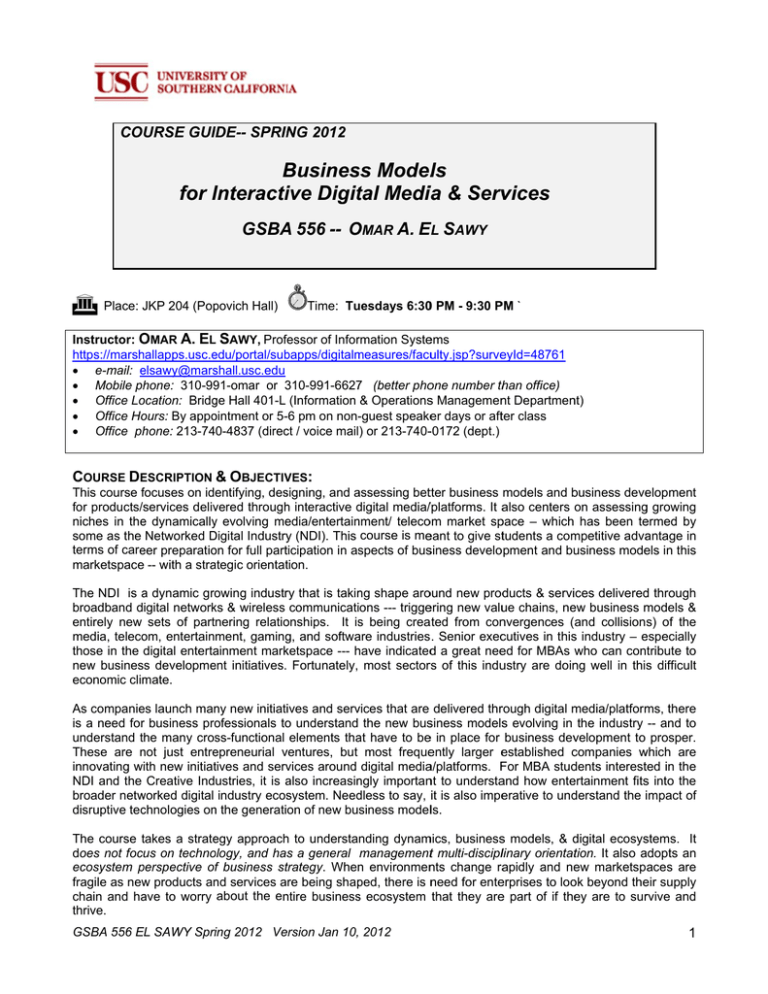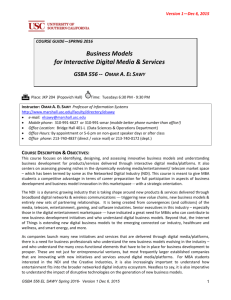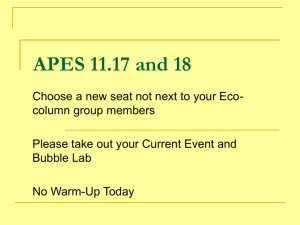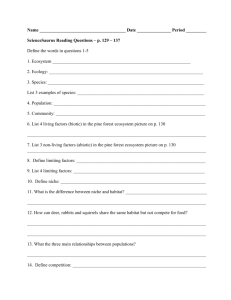B for I Interacti
advertisement

COURSE GUIIDE-- SPRIN NG 2012 Busines B ss Modells for Interacti I ive Digittal Mediia & Serv vices GSBA A 556 -- OMAR A. EL SAWY Place: JKP J 204 (Pop povich Hall) Time: Tu uesdays 6:30 0 PM - 9:30 P PM ` Instructor: OMAR A. EL SAWY, Proffessor of Inforrmation Syste ems https://marsh hallapps.usc.e edu/portal/sub bapps/digitalm measures/facu ulty.jsp?surve eyId=48761 e-mail: elsawy@mars e shall.usc.edu Mobile ph hone: 310-99 91-omar or 310-991-6627 3 7 (better pho one number th han office) Office Lo ocation: Bridg ge Hall 401-L (Information & Operationss Managemen nt Departmen nt) Office Ho ours: By appo ointment or 5--6 pm on non--guest speake er days or aftter class Office ph hone: 213-740-4837 (direc ct / voice mail) or 213-740--0172 (dept.) COURSE DESCRIPTION E & OBJECTIV VES: This course focuses f on identifying, des signing, and assessing a bettter business models and b business deve elopment for products/s services deliv vered through h interactive digital d media//platforms. It a also centers on assessing g growing niches in the e dynamically y evolving me edia/entertain nment/ teleco om market sp pace – which has been te ermed by some as the Networked Digital D Industry y (NDI). This course is me eant to give sttudents a com mpetitive adva antage in terms of care eer preparatio on for full partticipation in as spects of bussiness development and bu usiness mode els in this marketspace e -- with a stra ategic orientattion. The NDI is a dynamic gro owing industrry that is takin ng shape aro ound new prod ducts & serviices delivered d through broadband digital network ks & wireless communications --- trigge ering new valu ue chains, ne ew business m models & entirely new sets of partnering relatio onships. It is s being crea ated from con nvergences (and collisions) of the media, teleco om, entertainment, gaming g, and softwa are industries . Senior execcutives in thiss industry – e especially those in the digital enterta ainment mark ketspace --- have h indicated d a great nee ed for MBAs who can contribute to new business developme ent initiatives. Fortunately, most sectors rs of this indu ustry are doin ng well in this difficult economic clim mate. As companie es launch man ny new initiatiives and serv vices that are delivered thrrough digital m media/platform ms, there is a need forr business pro ofessionals to o understand the new bussiness modelss evolving in the industry -- and to understand the many cros ss-functional elements tha at have to be e in place for business devvelopment to prosper. These are not n just entre epreneurial ventures, v but most freque ently larger e established ccompanies w which are innovating with new initiattives and serv vices around digital media a/platforms. F For MBA stud dents interestted in the NDI and the Creative Industries, it is also a increasin ngly importan nt to understa and how ente ertainment fitss into the broader netw worked digital industry ecos system. Need dless to say, it is also impe erative to und derstand the impact of disruptive tec chnologies on n the generation of new business modells. The course takes t a strate egy approach h to understanding dynam mics, businesss models, & d digital ecosysstems. It does not focu us on techno ology, and has s a general managementt multi-discipllinary orientattion. It also a adopts an ecosystem perspective p off business sttrategy. When n environmen nts change ra apidly and ne ew marketsp paces are fragile as new w products an nd services are being shap ped, there is n need for ente erprises to loo ok beyond the eir supply chain and ha ave to worry about the en ntire business s ecosystem that they are e part of if the ey are to surrvive and thrive. GSBA 556 EL E SAWY Spriing 2012 Ve ersion Jan 10, 2012 1 This course uses lectures, case studies, articles, industry reports, and features industry guest speakers who provide current practice insights. The course draws on the expertise and contacts of CTM -- Marshall’s Institute for Communications Technology Management and its 20+ sponsoring companies www.marshall.usc.edu/ctm. Together with IOM 543 (Global Issues in the Networked Digital Industry) taught by Professor Francis Pereira in the Fall, this course also provides helpful skills for the $25K handsomely prized MBA Annual International Technology Strategy Business Case Competition http://management.bu.edu/casecomp/ to be held in Boston March 29-31, 2012, and co-sponsored by Ericsson. This course is also a good combo with GSBA 555 (Managing in the Creative Industries) taught by Professor Mark Young. SKILLS ACQUIRED THROUGH THIS COURSE: 1) How to scope and assess a business ecosystem niche in an emerging technology-intensive industry. 2) How to systematically identify, generate, build, & assess better business models for launching services provided through interactive digital media/platforms. 3) Use of new strategic frameworks and methods suited to rapidly changing industries with emerging technologies, structural discontinuities, & dynamic ecosystems. 4) Understanding of dynamics and value chains of the global telecom, entertainment, media, & gaming industries -- & how they are converging (& colliding). 5) Appreciation of partnering strategies for digital platforms in the entertainment / telecom space. 6) Familiarity with generation of alternative future scenarios for new services based on digital platforms. 7) Understanding new forms of customer value in digital ecosystems. THIS COURSE WOULD BENEFIT THOSE PURSUING CAREERS IN THESE FUNCTIONS Business Development --- Marketing --- Entrepreneurship --- Management Consulting --- Information Systems -- New Product Development --- General Management THIS COURSE WOULD BENEFIT THOSE PURSUING CAREERS IN THESE INDUSTRIES: Any industry that delivers services & content through broadband digital networks & interactive digital platforms -whether healthcare, consumer retail, or entertainment. Especially geared to careers in industries that depend heavily on services provided through interactive digital platforms such as telecom, media, entertainment, software, social networks, and online gaming SOUTHERN CALIFORNIA AS NEXUS OF THE NDI ECOSYSTEM AND THE CREATIVE INDUSTRIES While the NDI is a global industry, Southern California sits in a very special place at the heart of “Digital Hollywood” and the heart of the creativity and content industries from movies to television to music and games. Just to our north lies Silicon Valley with its world wide reputation for leading the changes in hardware and software that continue to drive the IT industry. To our south, in San Diego, lies the single largest concentration of wireless ingenuity and expertise in North America. To our West are countries such as Korea, China, India and others in the Pacific Rim—close enough for Los Angeles to be their gateway to North America for their leading edge experiences in new services delivered on digital platforms. As this new world is being born, we literally sit at its crossroads with the opportunity to watch, participate, and help rethink developments as the new business models of the NDI evolve into a new digital business ecosystem. Southern California is definitely associated with the “digital cool.” It is an exciting spot for USC to be in ! GSBA 556 EL SAWY Spring 2012 Version Jan 10, 2012 2 COURSE MATERIALS & READINGS 1. Harvard Business School Cases & Articles (Course Pack): The two-part course pack can be purchased online directly and downloaded in electronic form from Harvard Business Press -- as per the instructions provided in the BlackBoard class folder under syllabus. The article pack and case pack are separated as it is possible to access the articles (not the cases) for free through the USC libraries. 2. Other Readings: Articles from professional journals and trade press, and industry reports (to be made available on-line through BlackBoard class folder or distributed in class if hard copy). 3. Blackboard Course Folder: There will be a session preparation guide with case questions posted for every session on Blackboard. Other than the course pack that needs to be purchased (see item 1. above), other readings will be posted on Blackboard course folder – as will session PowerPoints, assignment instructions, administrative information, guest speaker bios etc.. Please check it frequently ! The sections that are populated typically are Syllabus, Assignments, and Content. RELATED BOOKS If you have any deeper special interest in any of the topics we will cover, these books are commendably intriguing and useful (not required) depending on your deeper interest. They cover new business models for digital platforms and ecological approaches to strategic innovation, digital innovation, as well as the evolution of the networked digital industry. They are listed in order of most recent publication date. Afuah, Allan Strategic Innovation: New Games for Competitive Advantage, Routledge, New York, 2009. Anderson, Chris FREE: The Future of a Radical Price, Hyperion Press, 2009. Knee, Jonathan, Bruce Greenwald, & Ava Seave The Curse of the Mogul: What’s Wrong with the Leading Media Companies, Penguin 2009. Osterwalder, Alexander & Yves Pigneur Business Model Generation: A Handbook for Visionaries, Game Changers, and Challengers, 2009. Reeves, Byron and Leighton Read, Total Engagement: Using Games and Virtual Worlds to Change the Way People Work and Businesses Compete, Harvard Business School Press, 2009. Bouwmann, Harry et. al (Editors) Mobile Service Innovation and Business Models, Springer-Verlag, 2008. Shuen, Amy Web 2.0: A Strategy Guide, O’Reilly Press, 2008. Tapscott, Don & Anthony Williams Wikinomics: How Mass Collaboration Changes Everything, Expanded Edition, Penguin Books, 2008. Chesbrough, Henry Open Business Models: How to Thrive in the New Innovation Landscape, Harvard Business School Press, 2006. Vesa, Jarkko Mobile Services in the Networked Economy, IRM Press, 2005. Alison Alexander et. al. Media Economics, Third Edition, Lawrence Erlbaum Assoc. New Jersey, 2004 (this is the required book for IOM 543: Global Issues in the Networked Digital Industry, taught by Professor Francis Pereira). Christensen, Clayton, Scott Anthony, & Erika Roth Seeing What’s Next: Using the Theories of Innovation to Predict Industry Change, Harvard Business School Press, 2004. Iansiti, Marco & Roy Levien The Keystone Advantage: What the New Dynamics of Business Ecosystems Mean for Strategy, Innovation, and Sustainability, Harvard Business School Press, 2004. GSBA 556 EL SAWY Spring 2012 Version Jan 10, 2012 3 Topic Cases/Assignments NDI ECOSYSTEM STRATEGY (Guest speakers TBA) VISOR Business Model Framework McKinsey Quarterly: 10 Tech-Enabled Trends to Watch Case #0: Ericsson SEJ: X-Boundary Disruptors Economist: Telecom in Emerging Mkts Case #1 Apple HBR: Strategy as Ecology HBS: SAP Ecosystem Orchestration Case #2: Wii Encore? HBR: Art of Managing Complementors SMR: Companies as Platform Leaders Case #3: Intellectual Ventures Inc. SMR: IP Strategy & Open Innovation HBR: Funding Eureka TOP VIEW of GSBA 556 COURSE Session # Date Part 1 1 Jan 10 Course Orientation & Introduction 2 Jan 17 DNA of the NDI: Digital Convergence or Creative Collisions ? 3 Jan 24 Ecological Approaches to Strategy & Digital Business Ecosystems 4 Jan 31 Complementors, Competitors, and Digital Platforms 5 Feb 7 Intellectual Property Strategy in Digital Business Ecosystems SCOPING YOUR ECOSYSTEM NICHE & NEW MARKETSPACES Part 2 6 Feb 14 Scoping your Digital Ecosystem Niche: Experimentation & Positioning 7 Feb 21 The Mobile Space Innovation Spurt 8 Feb 28 Scoping your Digital Ecosystem Niche: Your TV is Pinging ? 9 Mar 6 Scenario Generation & Futurecasting in the Digital Ecosystem Part 3 SPRING BREAK DESIGNING DIGITAL BUSINESS MODELS & NEW FORMS OF CUSTOMER VALUE Customer-Centric Business Models 10 Mar 20 11 Mar 27 User-Generated Content & Long Tail Business Models 12 Apr 3 Crowd-Sourcing Business Models 13 Apr 10 Web 2.0 & Social Networking Business Models Part 4 (Guest speakers TBA) Case #4 Google HBR: Reverse Engineering Google HBR: What’s Your Google Strategy Case #5 HTC HBR: Defeating Feature Fatigue Case #6 Hulu HBS: Brightcove & Internet TV HBR: Matching Innovation Strategy Report #1: NDI Ecosystem Niche Assessment Brief Due HBS: A Note on Scenario Planning (Guest Speakers TBA) Case #7 Make it Work HBR: Reinventing Your Business Model HBS: Best Buy Case Case #8 Sony Keitei Japan HBR: Should you Invest in Long Tail ? HBR: Strategies for 2-Sided Markets Case #9: TopCoder Orange: Porous Enterprise SMR: Open Innovation in Lean Times Case#10 LinkedIn HBR: When One Bus Model Not Enough HBR: Competing with Free GRANDE FINALE ! 14 Apr 17 15 Apr 24 ReVisioning Game Changers for the Future Project Presentations GSBA 556 EL SAWY Spring 2012 Version Jan 10, 2012 TBA Report #2: Business Model Proposal Report Due 4 COURSE EFFORT / GRADING INFORMATION Each individual's effort and grade will be based on the following 5 components. Please note that extraordinary effort in any of those components will be recognized. Conversely, plagiarism in written assignments will be dealt with very severely as per USC rules. 1. 2. 3. 4. 5. Class participation related to readings Team presentation & key recommendations for one case 2 case write-ups (individual) Report #1 (2 person Team Report) Report #2 (3 Person Team Report) 12 % 12 % 16 % 24 % 36 % [1] CLASS PARTICIPATION Your participation grade is based on quality and a sincere effort to provoke, learn and understand, rather than quantity. The more you engage with the class with passion, intellectual curiosity, and interest, the higher will be your participation grade, and the more successful and exciting our learning experience will be. We are all here to learn and share our understanding. Attendance: You are expected to attend all sessions. If you cannot attend for a specific reason then please inform the professor through e-mail that you are unable to attend, or you absence will affect your participation grade. Treat it like a professional meeting at work: if you cannot attend, you are expected to inform the person running the meeting as a professional courtesy. Engagement: You are expected to attend and prepare for each class and to actively engage in the discussion of readings and cases. If you don't keep up with the reading, you will not enjoy the class. Thus it is very important that you be prepared for each class. You are expected to actively discuss both readings and cases and add to the learning of the class, whether in the live classroom or on-line (if you see an article that is pertinent to the class – let us all know). You are also expected to raise questions that provoke the thinking of others. You may be randomly called upon in class to comment and answer questions, so please be prepared. You are also welcome to volunteer to act as a “deep diver” for a session, and informally give us more details on a topic or context they may have special expertise in. You are also very welcome and encouraged to spot and identify disruptive “game changers” to the digital business ecosystem and share with the class. Laptops & Mobile Devices: It is a professional courtesy to devote your full attention in the class as you would in a face-to-face meeting at work. If you are using a laptop or mobile phone/device to follow the class or take notes, that will be allowable. If you are using it for e-mail, instant messaging, twittering, etc.. or doing other assignments for other courses while in class, that will be deemed unprofessional and unallowable. Laptops will be closed during guest speaker presentations. Academic Accommodations for Disability: If you have any disability that requires special academic accommodations, please let us know ASAP. Any student requesting academic accommodations based on a disability is required to register with Disability Services and Programs (DSP) each semester. A letter of verification for approved accommodations can be obtained from DSP. Please be sure the letter is delivered to instructor as early in the term as possible. DSP is located in STU 301 and is open 8:30 a.m. – 5:00 p.m., Monday through Friday. The phone number for DSP is (213) 740-0776. [2] TEAM PRESENTATION & KEY RECOMMENDATIONS FOR ONE CASE Each case discussed in the course will have its key recommendations presented in executive summary form after the case discussion by two 2 person teams. Each team will be given a question to answer. Maximum time is 15 minutes and will include key recommendations and reasons why (rather than the entire case analysis). Team assignment rules and case sign-up will be provided. The team performance will be judged as to how succinctly they select key recommendations and reasons behind it. GSBA 556 EL SAWY Spring 2012 Version Jan 10, 2012 5 [3] WRITTEN CASE WRITE-UPS Written analysis is required for 2 of these 10 cases (one from each set) as follows: Write-up #1 (Individual) Case 1, 2, 3, 4, or 5 Write-up #2 (Individual) Case 6, 7, 8, 9, or 10 Note: The 2 written cases cannot be the same as the one you picked for presentation with a team. You need not tell us your choices but you are responsible for keeping track of them. Written analyses are due at the beginning of the session in which the case will be discussed. Case questions will be provided for each case to guide your write-up. The case write-ups should be the equivalent of about 2-3 single-spaced pages (and any appendices attached). Please provide your case in hard copy printed form unless you have a special circumstance. It is much faster and easier to write comments on the hard copy. The written analysis is an individual assignment. However, group discussion before write-up is good as long as write-up occurs separately and individually. If you would like detailed feedback on a specific aspect of your write-up, please feel free to include "feedback requests" in the body of your write-up. These are not “standard” case analyses. Just answer the questions. There is no need for a lengthy introduction in your write-up but rather please directly address the key issues suggested by the case questions. Try to avoid lengthy repetition of case facts (you can reference page numbers, exhibits, tables) -- but by all means justify your logic through case specifics. Please be careful to distinguish between case facts and stereotyped sweeping generalizations. Recommendations should be substantiated by clear logic and case specifics. Diagrams and schematics are very helpful in both sharpening your thinking and your exposition. Incorporation of learning from assigned readings and class material into analysis is a definite plus and is expected. [4] REPORT #1 (2 Person Team Project) NDI Ecosystem Niche Assessment You will be asked to each pick a niche in the NDI business ecosystem that interests you and map the NDI ecosystem from that perspective and prepare a brief for the consumption of VPs of business development in that niche. This will involve describing your selected NDI business ecosystem niche, and assessing the health of that niche, using various tools that will be discussed in class. More specific guidelines will be provided later. [5] REPORT #2 (3 Person Team Project) Business Model Proposal Students will work in teams of 3 to develop a business model proposal for a selected new service in the NDI business ecosystem. Business models for new products and services in the digital business ecosystem often make their way to reality through a variety of paths. The process is triggered variously: a new value proposition for a targeted customer segment through a service innovation, a new interface for content access through new media or a new device, a different service delivery platform, a different way of organizing channels, or a new revenue sharing or different pricing arrangement… More specific guidelines will be provided later. GSBA 556 EL SAWY Spring 2012 Version Jan 10, 2012 6






